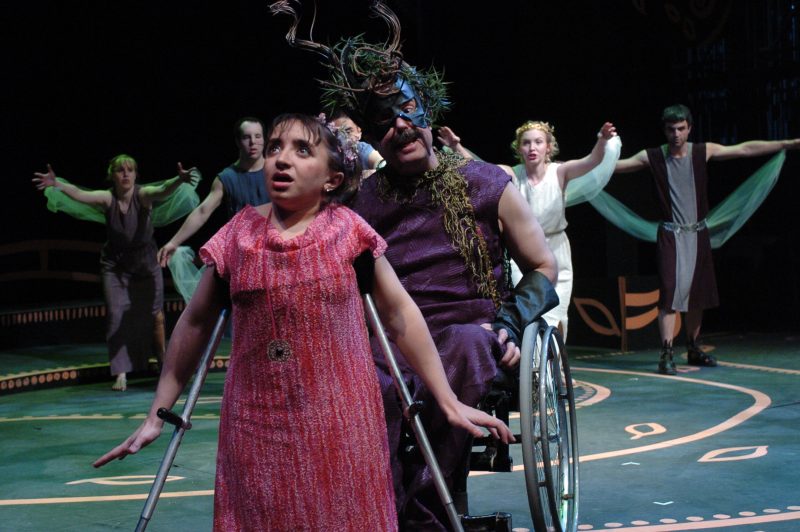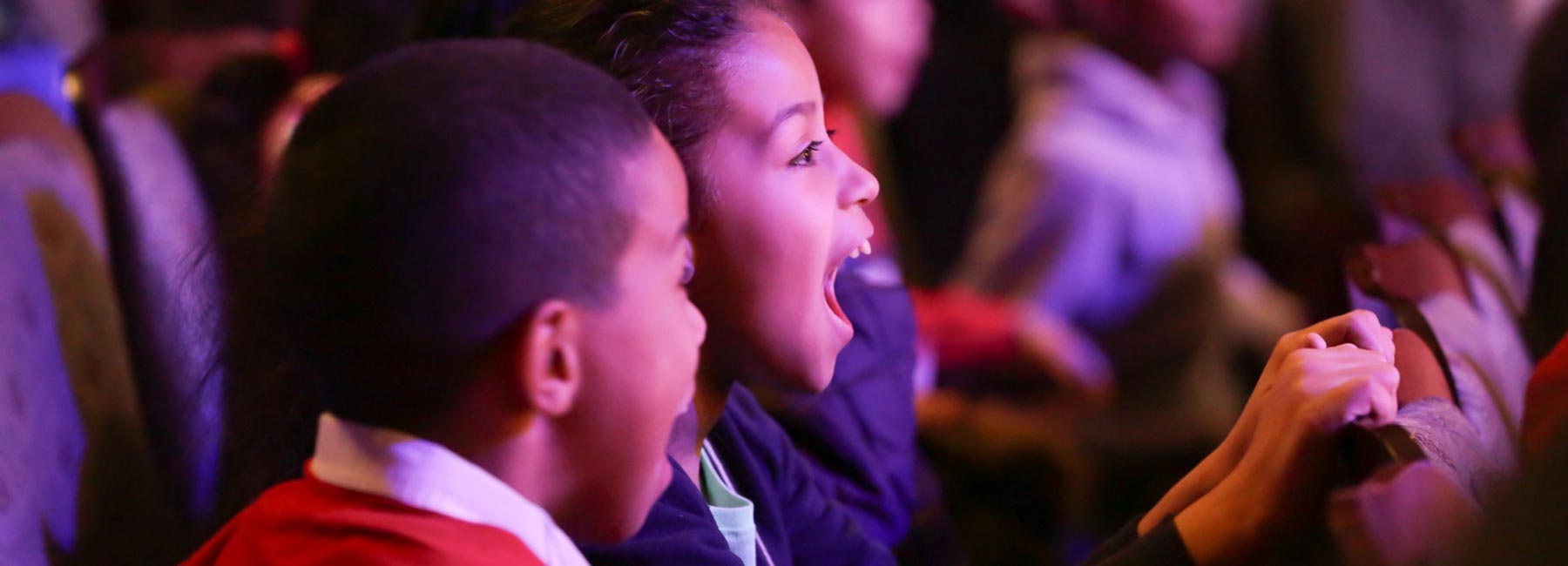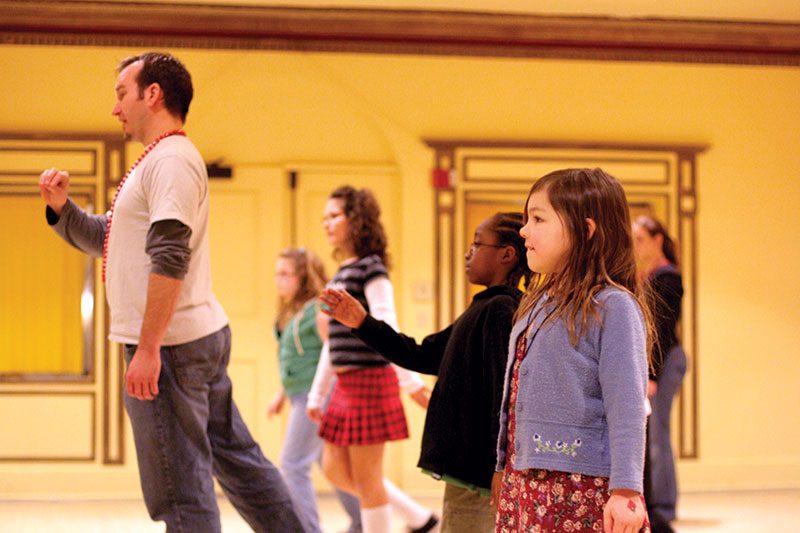While the power dynamics of the world have long supported that observation, the cultural sector seems to be increasingly embracing the opinions, perspectives and voices of children. Artists, arts administrators, and curators around the world are creating work with children, and programs for children, in ways that honor the people they are right now. Curious to understand the impulse behind, and importance of, some of these initiatives, I spoke to several artists and arts administrators whose artistic or institutional projects are engaging children and young people as collaborators, creators, curators, and fellow human beings.
From Denmark: Teatercentrum’s KulturCrews
In Denmark’s KulturCrews program, which is currently in one third of the schools in Denmark and continues to expand, young people are completely entrusted to handle every aspect of bringing art into their schools. They are tasked with curating the school’s artistic programming; booking the artists; running press and social media; being responsible for artist hospitality and all of the technical requirements of the actual live performances, not to mention learning how to talk about the works they’ve selected with their peers and teachers.
When I spoke to Henrik Køhler, Director of Teatercentrum, and Pernille Welent Sørensen, Consultant, about the KulturCrews, they mentioned how a couple of recent graduates went on to pursue political roles, citing the empowerment they experienced as part of the crew as their inspiration for going into politics. How might the world be a better place if kids everywhere had, as part of their formative years, the lived experience of being part of a collaborative group of peers trained to serve as their school’s cultural ambassadors?
From Scotland: Imaginate’s Wee Night Out
Young people have a way of busting through adults’ preconceived notions and offering fresh perspectives that are untethered to the way things have always been done. In Scotland, the curation of a coveted slot at the Edinburgh International Children’s Festival was entrusted to the young participants of Imaginate’s Wee Night Out. In the first year of the program, they selected Evil, a harrowing, autobiographical piece that dealt with bullying. Their selection of a dark, challenging work in turn challenged the adult presenters attending the festival to grapple with questions of what young people really want to see and why. Festival Director Noel Jordan describes the effect that particular selection, and the program as a whole, has had on his own curatorial choices: “Having access to the opinions of young people is incredibly important. It is a reminder and encouraged me to be braver in programming.”
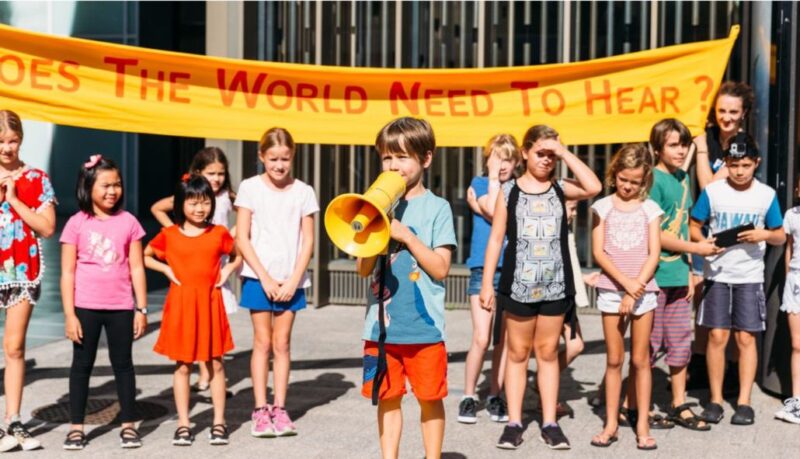
SMALL VOICES LOUDER / Maybe ( ) Together
From Australia: Maybe ( ) Together’s Small Voices Louder
Alex Desebrock, the aforementioned Australian artist whose company Maybe ( ) Together creates works with children, believes the world would be a better place if adults listened to children. “[Children] have a knack of saying what we need to hear. There is a tendency to say things that are inspiring or hopeful, brutally honest, or very funny, which reflects our society back at us. And they remind us that they’re inheriting our future, the future we give them.” Alex also describes moments when parents are surprised to learn how their own children engage with artists who are able to, through a process of safety in collaboration, bring new sides of the child to the fore.
“I think I learned really early on the power of an artist with a child, that the way we speak to them is very different than a teacher or a parent, and how important that is, and how when you do that, when you talk to them with respect and if you know that their voice is important, they really do step up. If people haven’t experienced that before, they can really underestimate children.”
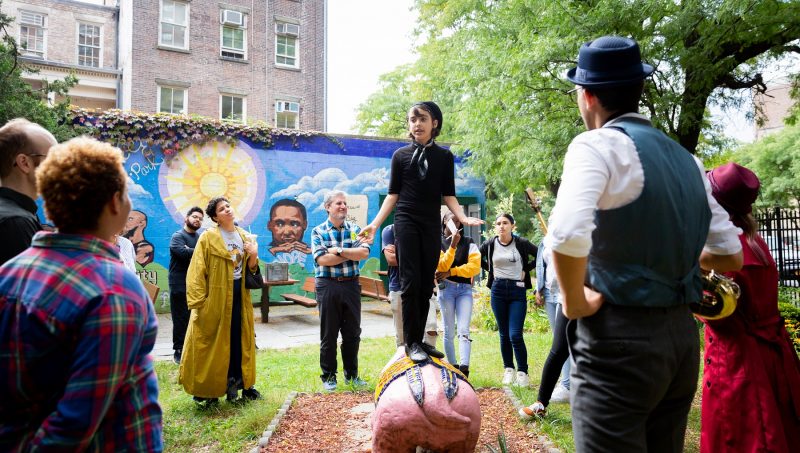
A scene from Trusty Sidekick's GUMSHOE. Buatti-Ramos Photography, courtesy of Trusty Sidekick Theater Company.
From the United States: Trusty Sidekick Theater Company’s Young Devisers
In their Young Devisers program, New York City’s Trusty Sidekick Theater Company paired a group of adult ensemble members with a group of 9-13 year-olds to devise and perform a site-specific piece entitled Gumshoe. Renata Melillo Townsend, Head of Enrichment at Trusty Sidekick, recalls, “The adult actors were blown away by these young people; it reengaged the actors in the company in the sense that they got a different perspective on what a young person is capable of.” The company’s managing director, Paul Brewster explains how, in devising the piece, the young people helped shape the source material by expressing what they found interesting and by collaborating with Trusty’s Artistic Director, Drew Petersen..
“Time and time again, the young people gave us so much information and inspiration,” Paul says. The finished work incorporated young people’s voices and creative expression, reflecting co-ownership and empowerment in recognizing their input on equal footing with that of the adults.
A common echo through my conversations with practitioners was that the adults involved in working with young people need to carefully consider how their presence might affect the young people’s participation. Adults pursuing working with young people must be mindful of when to let go and listen; and when to invite dialogue and embrace the collaborative process. Artist Darren O’Donnell of Canada’s Mammalian Diving Reflex company, known for a relational piece in which kids between the ages of eight and twelve give haircuts to grownups, works alongside children as artmakers. “Artistically, it’s really interesting working with kids because it makes for beautiful things, it makes for surprising things, for questioning the fabric in reality. So I just think it makes better art.” At The New Victory Theater in New York City, kids are invited to give feedback to artists whose works are being developed in their new work development program, LabWorks, finding that kids regularly offer insightful viewpoints and valuable guidance for how artists might shape their work going forward.
"Giving kids agency, entrusting young people with decision-making or including them in an artistic process is a symbiotically beneficial exercise for both children and adults. Children stand to learn that their voices matter, a lesson they’ll hopefully internalize enough to grow up to change the world. Or, not wanting to wait till then, they might feel empowered to stand up right now."
Giving kids agency, entrusting young people with decision-making or including them in an artistic process is a symbiotically beneficial exercise for both children and adults. Children stand to learn that their voices matter, a lesson they’ll hopefully internalize enough to grow up to change the world. Or, not wanting to wait till then, they might feel empowered to stand up right now. Perhaps it’s in our best interest as adults to listen closely. Greta Thunberg, a Swedish teen, recently started a global movement and got the world to pay attention to the issue of climate change in a way that few adults have managed to do. So, young people have something of value to say to the rest of us. Adults who are open to the exercise of releasing control and accepting the viewpoints of children are consistently surprised by the depth of understanding, heightened creativity and emotional complexities that young people regularly bring to the table.
On another recording made by Alex Desebrock as part of Small Voices Louder, a young voice offers a call to action that all theatermakers should consider for their work with young people and in their own practice: “I want to be the big voice to say, let’s try another way, let’s go another path.”

